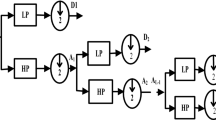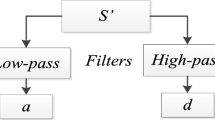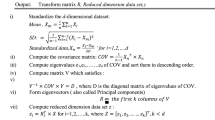Abstract
In this paper, a technique primarily based on the discrete wavelet transform (DWT) and the slip associated with a neural network (NN) for classification and fault detection of broken rotor bars in an induction machine has been proposed. The calculated energy in each decomposition level obtained by the DWT analysis and the slip of the motor are used as input to the classifier in order to diagnose the healthy and faulty classes. The advantage of this method lays in the use of one single current sensor with the slip factor in order to detect the presence of the fault and identify the number of broken bars under different load conditions. The DWT analysis is proposed to overcome the limitation of the Fourier analysis and it is mainly adapted for the non-stationary signals. Moreover, the slip factor is applied as a second input on the classifier of NN to eliminate the problem of low-load. Feed-forward multi-layer Perceptron neural network is chosen as a technique to classify the fault in an induction machine. This technique is performed and validated by experimental data.



















Similar content being viewed by others
References
Ameid T, Menacer A, Talhaoui H, Harzelli I (2017a) Broken rotor bar fault diagnosis using fast Fourier transform applied to fieldoriented control induction machine: simulation and experimental study. Int J Adv Manuf Technol 92:917–928. https://doi.org/10.1007/s00170-017-0143-2
Ameid T, Menacer A, Talhaoui H, Harzelli I (2017b) Rotor resistance estimation using Extended Kalman filter and spectral analysis for rotor bar fault diagnosis of sensorless vector control induction motor. Measurement 111:243–259. https://doi.org/10.1016/j.measurement.2017.07.039
Ameid T, Menacer A, Talhaoui H, Azzoug Y (2018) Discrete wavelet transform and energy eigen value for rotor bars fault detection in variable speed field-oriented control of induction motor drive. ISA Trans 79:217–231. https://doi.org/10.1016/j.isatra.2018.04.019
Arabacı H, Bilgin O (2010) Automatic detection and classification of rotor cage faults in squirrel cage induction motor. Neural Comput Applic 19:713–723. https://doi.org/10.1007/s00521-009-0330-7
Asfani DA, Muhammad AK, Yafaruddin S, Purnomo MH, Hiyama T (2012) Temporary short circuit detection in induction motor winding using combination of wavelet transform and neural network. Expert Syst Appl 39:5367–5375. https://doi.org/10.1016/j.eswa.2011.11.048
Bessam B, Menacer A, Boumehraz M, Cherif H (2016) Detection of broken rotor bar faults in induction motor at low load using neural network. ISA Trans 64:241–246. https://doi.org/10.1016/j.isatra.2016.06.004
Bessam B, Menacer A, Boumehraz M, Cherif H (2017) Wavelet transform and neural network techniques for inter turn short circuit diagnosis and location in induction motor. Int J Syst Assur Eng Manag 8:478–488. https://doi.org/10.1007/s13198-015-0400-4
Bouzida A, Touhami O, Ibtiouen R, Belouchrani A, Fadel M, Rezzoug A (2011) Fault diagnosis in industrial induction machines through discrete wavelet transform. IEEE Trans Ind Electron 58:4385–4395. https://doi.org/10.1109/TIE.2010.2095391
Chahine K (2018) Rotor fault diagnosis in induction motors by the matrix pencil method and support vector machine. Int Trans Electr Energy Syst 28:1–13. https://doi.org/10.1002/etep.2612
Chang HC, Lin SC, Kuo CC, Hsieh CF (2016) Induction motor diagnostic system based on electrical detection method and fuzzy algorithm. Int J Fuzzy Syst 18:732–740. https://doi.org/10.1007/s40815-016-0199-4
Cherif H, Menacer A, Bessam B, Kechida R (2015) Stator inter turns fault detection using discrete wavelet transform. Diagnostics Electr Mach Power Electron Drives (SDEMPED), 2015 IEE 10th Int Symp. https://doi.org/10.1109/DEMPED.2015.7303681
Costa C, Kashiwagi M, HugoMathias M (2015) Rotor failure detection of induction motors by wavelet transform and Fourier transform in non-stationary condition. Case Stud Mech Syst Signal Process 1:15–26. https://doi.org/10.1016/j.csmssp.2015.05.001
Gangsar P, Tiwari R (2019) A support vector machine based fault diagnostics of Induction motors for practical situation of multi-sensor limited data case. Meas J Int Meas Confed 135:694–711. https://doi.org/10.1016/j.measurement.2018.12.011
Gangsar P, Tiwari R (2020) Signal based condition monitoring techniques for fault detection and diagnosis of induction motors: a state-of-the-art review. Mech Syst Sig Process 144:1–37. https://doi.org/10.1016/j.ymssp.2020.106908
Ghate VN, Dudul SV (2010) Optimal MLP neural network classifier for fault detection of three phase induction motor. Expert Syst Appl 37:3468–3481. https://doi.org/10.1016/j.eswa.2009.10.041
Gunerkar RS, Jalan AK, Belgamwar SU (2019) Fault diagnosis of rolling element bearing based on artificial neural network. J Mech Sci Technol 33:505–511. https://doi.org/10.1007/s12206-019-0103-x
Harzelli I, Menacer A, Ameid T (2020) A fault monitoring approach using model-based and neural network techniques applied to input–output feedback linearization control induction motor. J Ambient Intell Human Comput 11:2519–2538. https://doi.org/10.1007/s12652-019-01307-0
Heo S, Lee JH (2018) Fault detection and classification using artificial neural networks. IFAC-PapersOnLine 51:470–475. https://doi.org/10.1016/j.ifacol.2018.09.380
Karnavas YL, Chasiotis ID, Vrangas A (2017) Fault diagnosis of squirrel-cage induction motor broken bars based on a model identification method with subtractive clustering. Diagnostics Electr Mach Power Electron Drives (SDEMPED), 2017 IEE 11th Int Symp. https://doi.org/10.1109/DEMPED.2017.8062372
Karouni A, Daya B, Bahlak S (2011) Offline signature recognition using neural networks approach. Procedia Comput Sci 3:155–161. https://doi.org/10.1016/j.procs.2010.12.027
Kia SH, Henao H, Capolino GA (2009) Diagnosis of broken-bar fault in induction machines using discrete wavelet transform without slip estimation. IEEE Trans Ind Appl 45:1395–1404. https://doi.org/10.1109/TIA.2009.2018975
Liang X (2019) Temperature estimation and vibration monitoring for induction motors and the potential application in electrical submersible motors. Can J Electr Comput Eng 42:148–162. https://doi.org/10.1109/CJECE.2018.2875111
Liu R, Yang B, Zio E, Chen X (2018) Artificial intelligence for fault diagnosis of rotating machinery: a review. Mech Syst Signal Process 108:33–47. https://doi.org/10.1016/j.ymssp.2018.02.016
Maouche Y, Oumaamar MEK, Boucherma M, Khezzar A, Razik H (2019) The propagation mechanism of fault signatures in squirrel cage induction motor drives. J Electr Eng Technol 14:121–133. https://doi.org/10.1007/s42835-018-00037-1
Muetze A, Niskanen V, Ahola J (2014) On radio-frequency-based detection of high-frequency circulating bearing current flow. IEEE Trans Ind Appl 50:2592–2601. https://doi.org/10.1109/TIA.2013.2296626
Niu FL, Huang J, Yang JQ, Chen LY, Jin H (2006) Rotor broken-bar fault diagnosis of induction motor based on HHT of the startup electromagnetic torque. Front Electr Electron Eng China 1:188–193. https://doi.org/10.1007/s11460-006-0022-3
Ojaghi M, Sabouri M, Faiz J (2018) Performance analysis of squirrel-cage induction motors under broken rotor bar and stator inter-turn fault conditions using analytical modeling. IEEE Trans Magn 54:1–5. https://doi.org/10.1109/TMAG.2018.2842240
Puche-Panadero R, Pineda-Sanchez M, Riera-Guasp M, Roger-Folch J, Hurtado-Perez E, Perez-Cruz J (2017) Improved resolution of the MCSA method via Hilbert transform, enabling the diagnosis of rotor asymmetries at very low slip. IEEE Trans Energy Convers 24:52–59. https://doi.org/10.1109/TEC.2008.2003207
Ramu SK, Irudayaraj GCR, Subramani S, Subramaniam U (2020) Broken rotor bar fault detection using Hilbert transform and neural networks applied to direct torque control of induction motor drive. IET Power Electron 13:3328–3338. https://doi.org/10.1049/iet-pel.2019.1543
Singh G, Naikan VNA (2017) Infrared thermography based diagnosis of inter-turn fault and cooling system failure in three phase induction motor. Infrared Phys Technol 87:134–138. https://doi.org/10.1016/j.infrared.2017.10.007
Talhaoui H, Menacer A, Kessal A, Kechida R (2014) Fast fourier and discrete wavelet transforms applied to sensorless vector control induction motor for rotor bar faults diagnosis. ISA Trans 53:1639–1649. https://doi.org/10.1016/j.isatra.2014.06.003
Talhaoui H, Menacer A, Kechida R (2015) Mixed eccentricity fault diagnosis in the sensorless field oriented control induction motor using DWT technique. Diagnostics Electr Mach Power Electron Drives (SDEMPED), 2015 I.E. 10th Int Symp 97–103. https://doi.org/https://doi.org/10.1109/DEMPED.2015.7303675
Talhaoui H, Menacer A, Kessal A, Ameid T (2017) Experimental diagnosis of broken rotor bars fault in induction machine based on Hilbert and discrete wavelet transforms. Int J Adv Manuf Technol 95:1399–1408. https://doi.org/10.1007/s00170-017-1309-7
Vas P (1993) Parameter estimation, condition monitoring, and diagnosis of electrical machines. Oxford, U K, Clarendon
Zhang J, Zhu N, Yang L, Yao Q, Lu Q (2007) A fault diagnosis approach for broken rotor bars based on EMD and envelope analysis. J China Univ Min Technol 17:205–209. https://doi.org/10.1016/S1006-1266(07)60073-X
Zolfaghari S, Mohd Noor SB, Mehrjou MR, Marhaban MH, Mariun N (2018) Broken rotor bar fault detection and classification using wavelet packet signature analysis based on Fourier transform and multi-layer perceptron neural network. Appl Sci 8:1–21. https://doi.org/10.3390/app8010025
Acknowledgements
The authors would like to thank Professor Menacer Arezki at the LGEB Laboratory, Biskra, Algeria, for his help.
Author information
Authors and Affiliations
Corresponding author
Additional information
Publisher's Note
Springer Nature remains neutral with regard to jurisdictional claims in published maps and institutional affiliations.
Appendix
Appendix
1.1 Simulation parameter
PnM | rated power | 1.1 kW |
IM | rated current | 2 0.5/4.3 A |
VM | rated line voltage | 230 V |
fN | frequency | 50 Hz |
pM | number of pole pairs | 1 |
RM | average diameter at the air gap | 35.76 10–3 m |
lM | length of the rotor | 65 10–3 m |
eM | air-gap diameter | 0.2 10–3 m |
NrM | number of bars | 16 |
NsM | number of turns per phase | 160 |
RsM | resistance of a stator phase | 7.58 Ω |
RbM | resistance of a rotor bar | 150 10–6 Ω |
ReM | resistance of a ring portion | 150 10–6 Ω |
LeM | short circuit ring leakage inductance | 0.1 10–6 H |
LbM | leakage inductance of a rotor bar | 0.1 10–6 H |
LsfM | stator leakage inductance | 26.5 10–3 H |
JM | inertia moment | 5.4 10–3 kg.m2 |
1.2 Experimental parameter
PnM | rated power | 1.1 kW |
IM | nominal current | 2 0.5/4.3 A |
VM | nominal line voltage | 400/230 V |
pM | number of pole pairs | 2 |
Υ | connection | |
JM | inertia moment | 0.0124 kg.m2 |
FM | damping coefficient | 0.0029 N.m/rad/s |
Rights and permissions
About this article
Cite this article
Talhaoui, H., Ameid, T. & Kessal, A. Energy eigenvalues and neural network analysis for broken bars fault diagnosis in induction machine under variable load: experimental study. J Ambient Intell Human Comput 13, 2651–2665 (2022). https://doi.org/10.1007/s12652-021-03172-2
Received:
Accepted:
Published:
Issue Date:
DOI: https://doi.org/10.1007/s12652-021-03172-2




